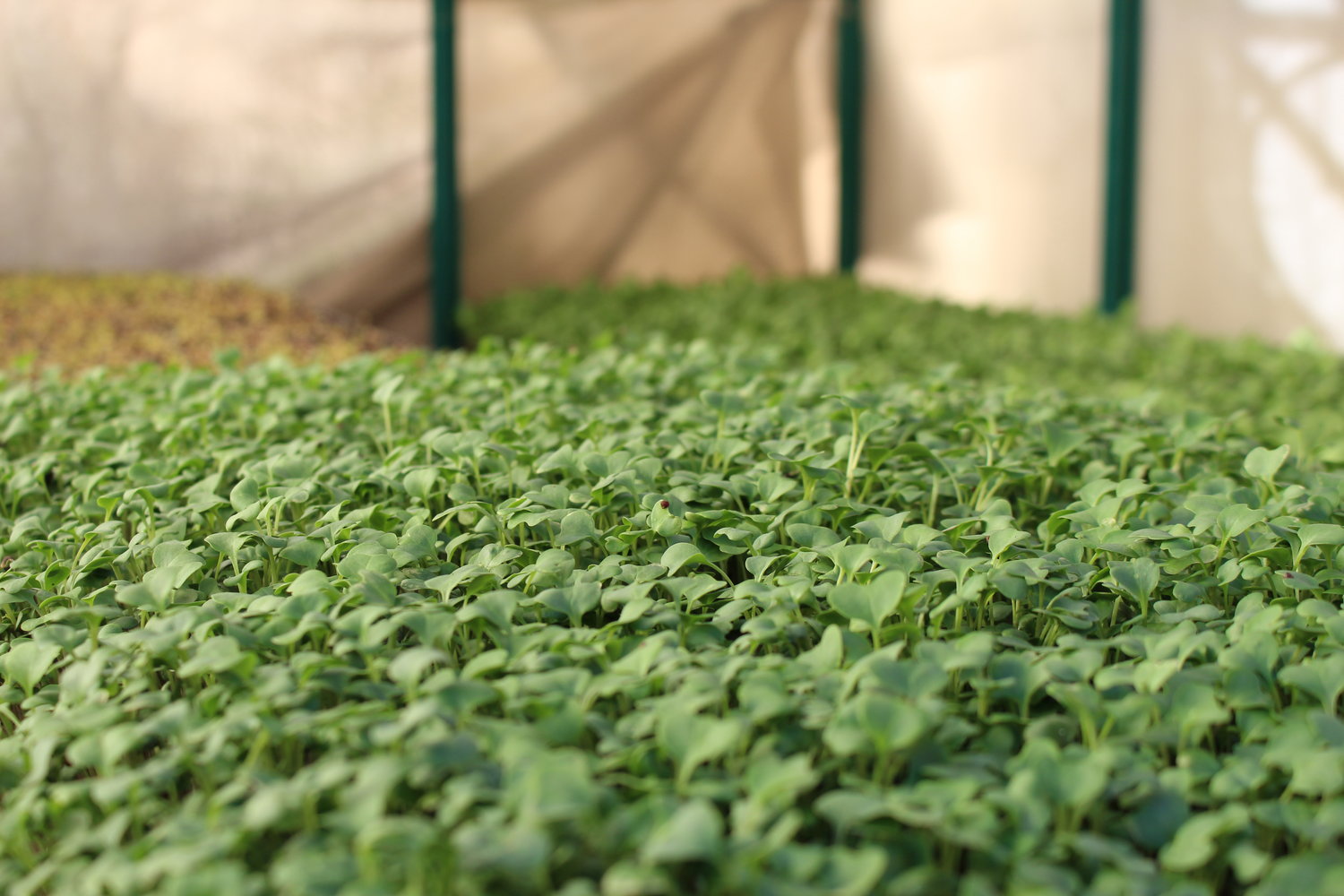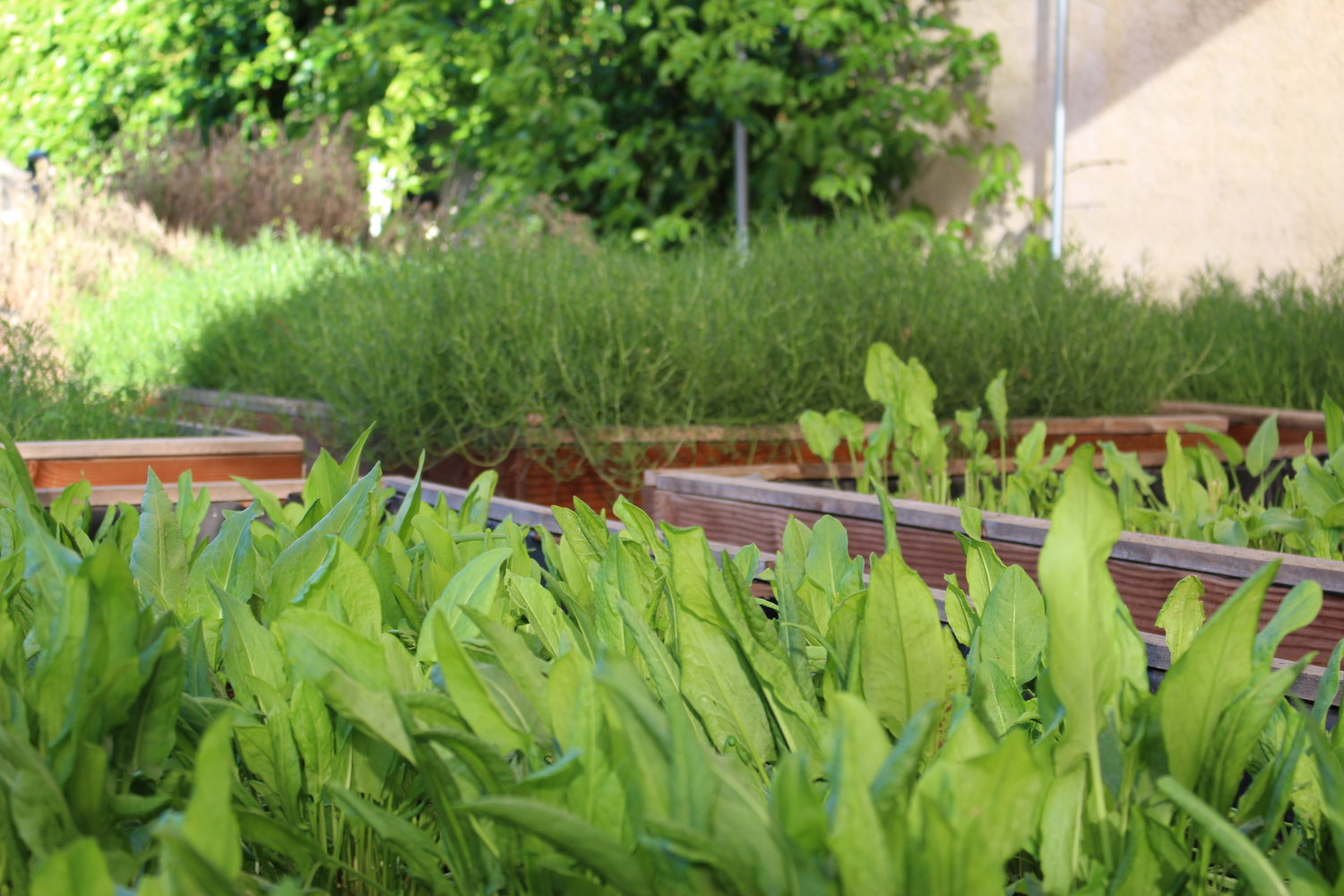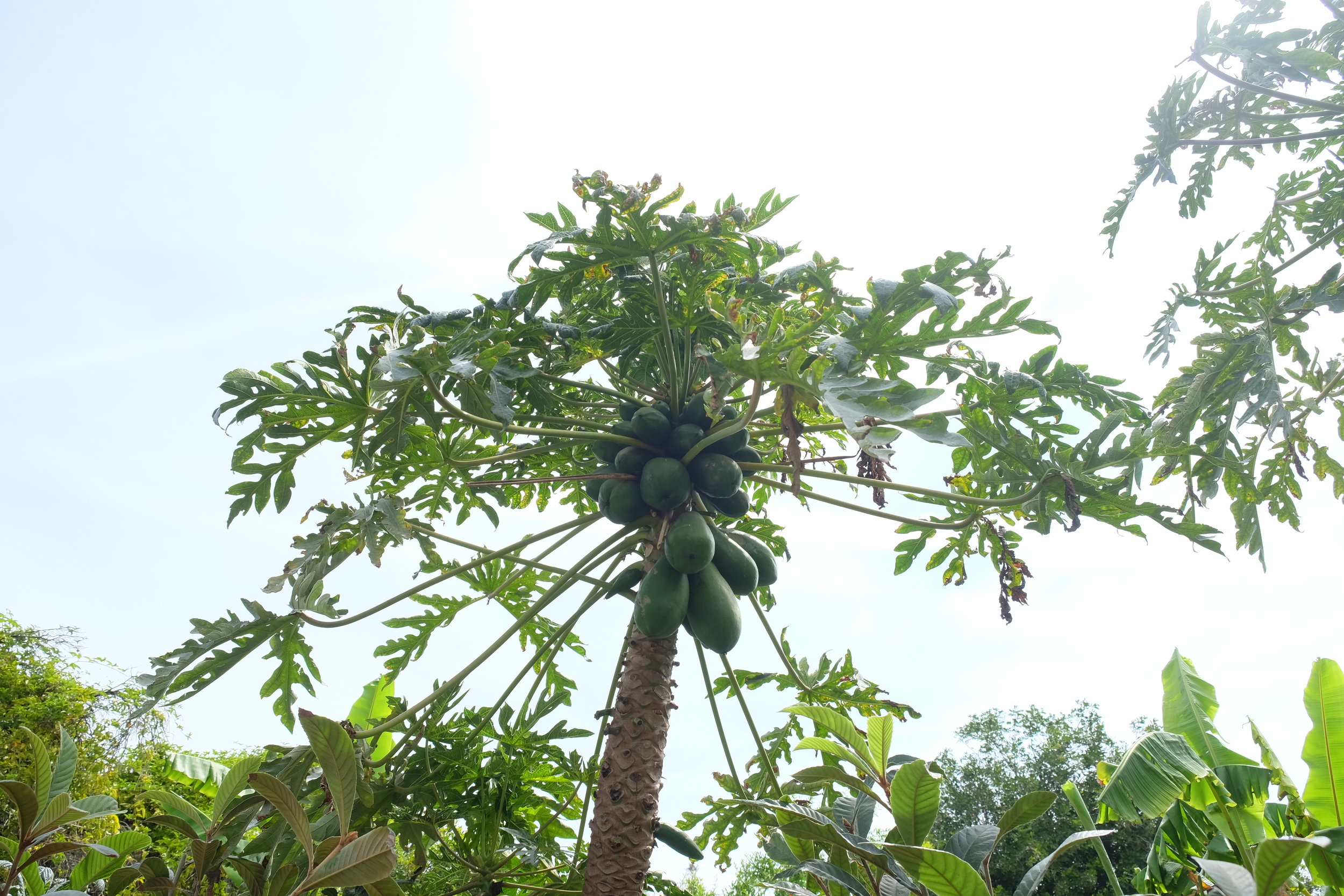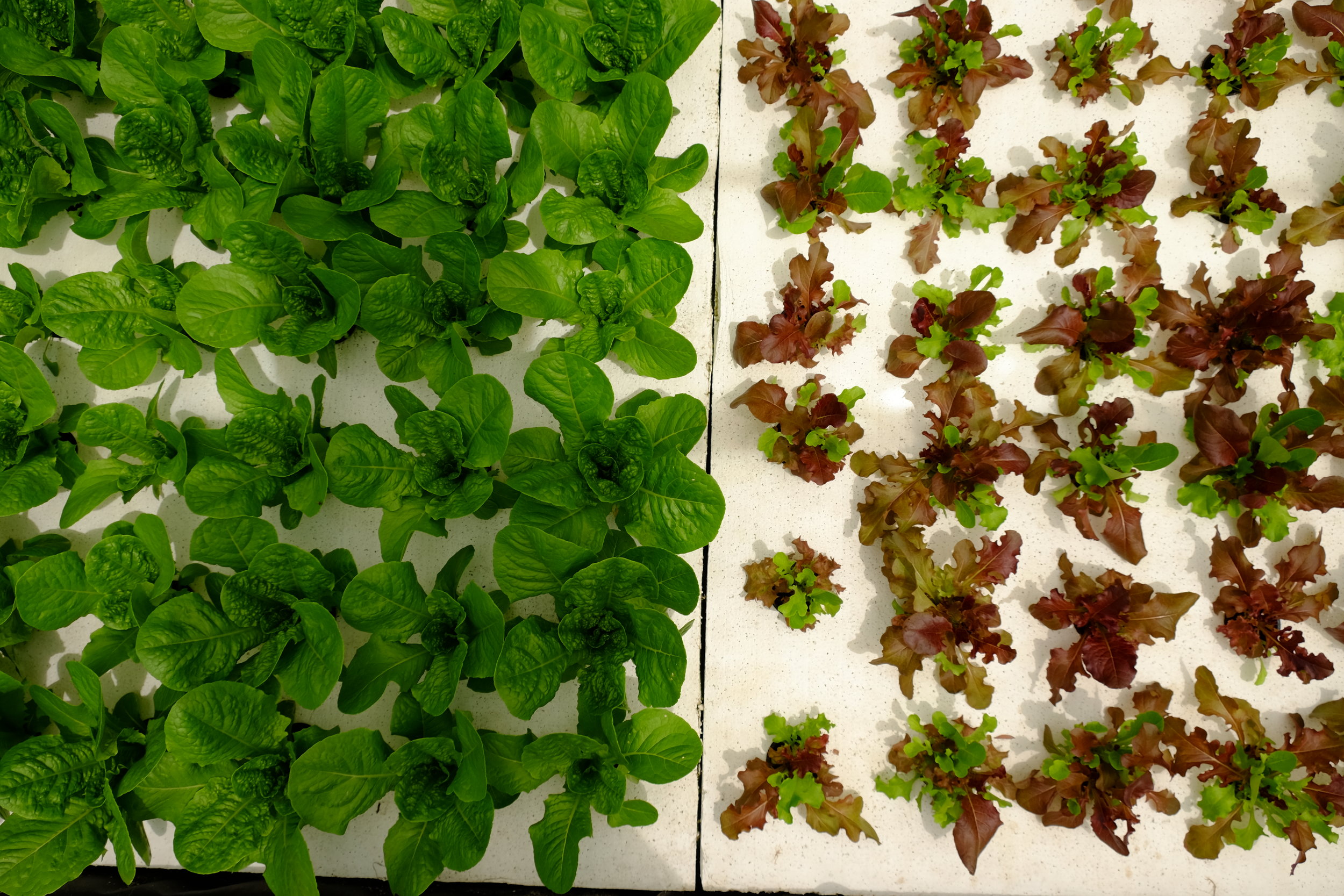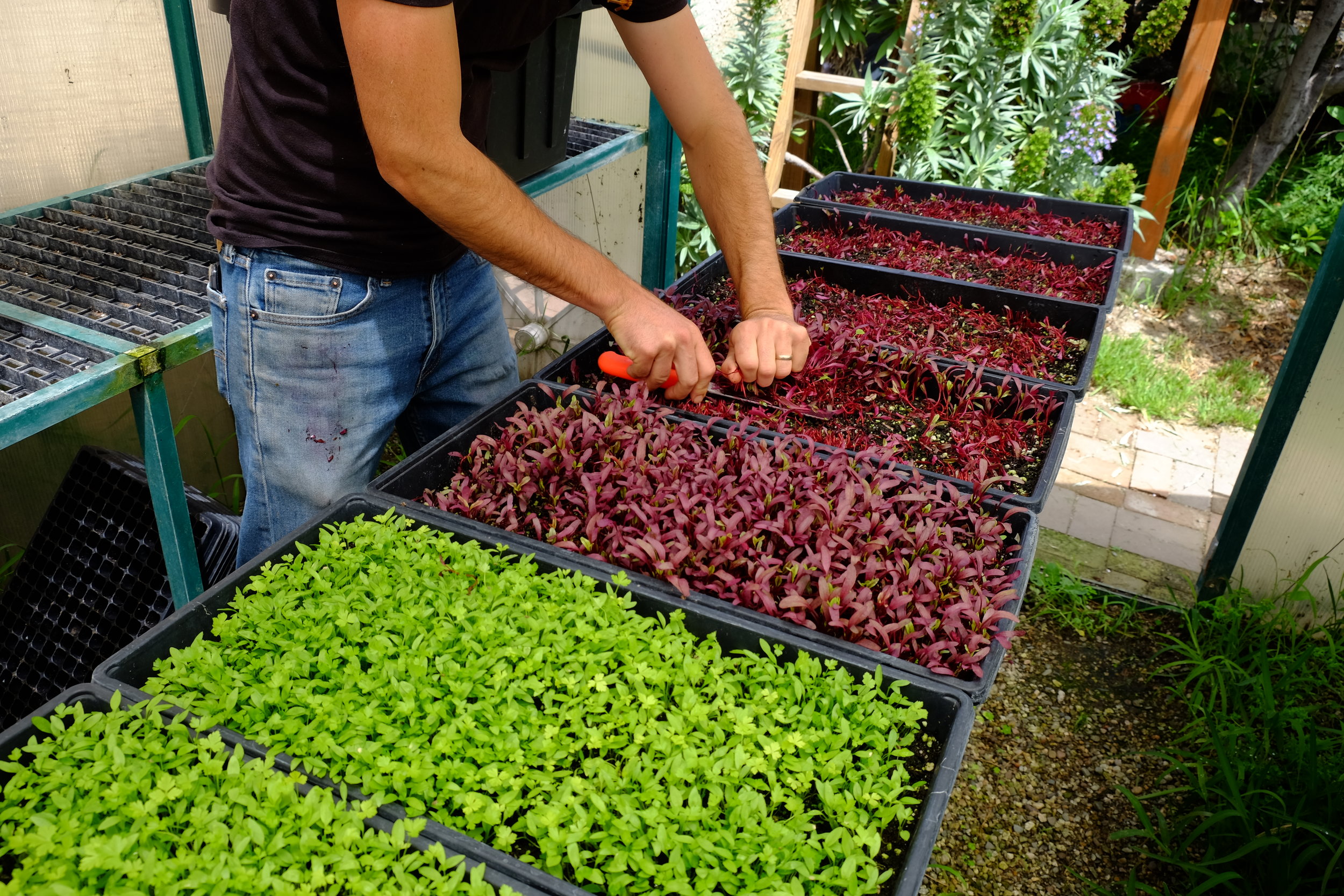How We Grow
Why Huarache? We decided to call oursevles Huarache Farms (Espanol for sandals) because we share a love of minimalist running and plant-based eating. Inspired by the Tarahumara runners of Chihuahua Mexico, who grow their own mustard greens, beans, chia seeds, and corn, we strive to have a light environmental footprint and to keep on running. Our mission is to create community through gardening, science, cooking, and running for mental health. Come run with us!
Read Born to Run to learn more about the Tarahumara.
A SUSTAINABLE APPROACH To Food Production:
At Huarache Farms, we utilize hydroponics, water gardens, wicking soil beds, mist irrigation, and micro orchard culture to grow food on a backyard scale.
Our farms emphasize a thoughtful approach to growing fruits and vegetables. This means taking a hard look at both conventional and organic growing methods, selecting ideas that work and are safe, and avoiding other practices that harm the environment, people, pets, and beneficial organisms. If we are too conventional, we risk destroying the life of the soil; if we are too organic, we risk not being productive enough to make a farm economically sustainable. In the modern world, most people do not farm, and an understanding of agricultural science is lost on many of us. To gain some context behind the history and science of soil fertility, please read An Unlikely Fix, by Adam Merberg.
Here’s something many people aren’t aware of: Fertilizing veggies organically (manure, compost, alfalfa meal) vs conventionally (salt minerals) is not an apples to apples comparison in terms of crop yields. Many people scratch their heads in thinking “why doesn’t everyone just switch to organic fertilizers and stop using chemical fertilizer?” The reason is because organic fertilizers in general are slow to work and in many cases expensive. It may come as a surprise that most farmers use both organic AND conventional fertilizers together. This is because one provides a very slow release of nutrients, and the other is very fast.
Here’s a direct question to the person reading this right now: Have you ever tried to make a living by growing and selling vegetables? If the answer is “no", I would like to humbly ask you to reserve your judgements and walk in our shoes for a few minutes.
For farmers whose livelihoods depend on consistent crop yields, using mineral fertilizer is often the difference between the business staying alive or folding. It’s worth noting how much food and how many people there are on planet Earth today. From a soil fertility standpoint, we didn’t get this many people with just organic fertilizers, we did it with mineral fertilizer as well. While mineral fertilizers often get a bad rap, we think that they’re misunderstood, taken for granted, and an ancient practice that dates back to the Middle Ages.
A Brief History of Saltpeter and the Petermen:
At some point in roughly 1270 AD, farmers in medieval Europe were pioneering techniques that would later give rise to our current understanding of chemistry. A barn where cows and other animals were kept had a subterranean room beneath, and floorboards by which the animal’s manure and urine could be swept below. Underneath the barn, the farmer would place a mound of straw, known as a nitre bed. To the straw, they would add pot ashes (the wood ashes collected from a wood fire, used to boil something like a rabbit stew). Pot ashes were likely added to reduce the odor of animal urine and ward off flies. “Pot-ash-ium” was later renamed Potassium (K+), which is a mineral that’s in plants and especially wood. When it’s burned, all the carbon, hydrogen, and oxygen have gone into the air. What’s left is the ashes, most of which is potassium carbonate (K2C03). Urine and manure from the animals would fall onto the nitre bed. The carbon in the straw would allow for Nitrosomonas and Nitrobacter bacteria to grow, eating the ammonium from the animal excreta, eventually turning it into a nitrate ion (NO3-). The positively charged potassium (K+) and negatively charged nitrate (NO3-) would attract and form a chemical bond, creating potassium nitrate (KNO3). With enough straw, pot ashes, and animal waste, so much potassium nitrate would be produced that a visible crystal began to grow out of the nitre bed. It was a concentrated salt containing Nitrogen and Potassium. These crystals were called saltpeter and would be collected by a Saltpeter Man. This would be used to fertilize the fields to grow crops like wheat and rye, but much of it would be taken to the nearest castle, where the local alchemist would combine it with sulfur and charcoal to make black powder (gunpowder). This allowed for relatively unskilled armies to be equipped with guns, which could take over more farms, to create larger armies. Agricultural might lead to military might, and to some extent this is how nations were built. The colonization and subjugation of people across the world and throughout history has been a painful and shameful consequence of all this power, and yet we find ourselves in a tentatively post war, disease, and famine world.
Future alchemists discovered another important plant nutrient after boiling human urine. After all the water had boiled off, what was left was a kind of salt. When this salt was scraped into a large enough quantity, the alchemist Hennig Brand found that if he held this salt over a flame there was an amazing phosphoresence, or bright light, given off, so he named it Phosphorus. All of these discoveries eventually coalesced into what would later be referred to as the big three macronutrients: N-P-K (nitrogren, phosphorus, potassium). Other scientists would discover that plants need not just NPK, but also other micronutrients like calcium, magnesium, iron, copper, chloride, boron, molybdenum, sulfur, and zinc. Many scientists now regard the ocean and its 90 trace minerals to represent the most complete list of plant nutrients (fish, algae, kelp, and all known sea organisms are known to contain 90 trace elements). While the ocean is a great way to add trace minerals to farmland, most of the salt in the ocean is sodium chloride, so unfortunately it can only be used sparingly before it starts to reduce growth rates.
The rampant and unrestrained use of mineral fertilizer across the world for the last century has lead to severe nutrient pollution and excessive eutrophication of rivers, lakes, and oceans. It has degraded soils by burning up soil carbon. It has lead to the overproduction of cheap livestock feed and processed foods. To put this into perspective, the greatest damage is centered around crops grown for livestock (corn, soybeans, wheat, rapeseed, and rice) and the soil tillage that is used to remove crop residues in between crops. Soil tillage leads to soil erosion (soil particles and mineral fertilizers being washed or blown away by rain and wind because it sits bare, without any roots holding onto it). This combination of crops grown for animal agriculture and soil tillage is why fertilizers now have a bad reputation. People can see the results, and they’re furious. We would say it’s more accurate to say that the real culprit here is not the fertilizer itself, but rather poor land management and a profit-driven mentality gone awry. With great power comes great responsibility. Anyone who uses mineral fertilizer must use it wisely and have a certain level of reverence for what they’re doing. A realization that this is a precious natural resource that must not be squandered or washed downstream with impunity. With all the fertilizers used to grow livestock feed, massive quantities of animal manure plague concentrated feeding operations, which pollutes groundwater, neighboring watersheds, and increases the risk of foodborne illness of raw vegetables being grown nearby.
Consider these thought experiments:
A common question people ask me at the farmers market is: was this grown with chemicals? What a loaded question! I’ve often wondered about the chemical sodium chloride (NaCl or table salt), and I know that patrons at a restaurant wouldn’t think of asking the chef, “did you add chemicals to this food?” But in truth, chemicals were added in the form of table salt. Most people don’t think of table salt as having any similarity to fertilizers, but they are. Both are crystalline salts that dissolve in water, and chloride (Cl-) is a micronutrient needed by plants and part of most fertilizers. Many people mistakenly lump words like fertilizer, pesticide, hazmat suit, and DDT all into the same category, as if they’re somehow interchangeable by using the word “chemical.”
Try to imagine as many organic fertilizers as you can. Jot them down on a list. Now try and imagine how they came to be, where they came from, how they were grown? In general, organic fertilizers are not made by using other organic fertilizers, but rather with mineral fertilizers. Some exceptions would be things like seaweed, bat and bird guano (taken from the natural world and represents a small fraction of the total fertility added to farmlands across the world). Alfalfa Meal? It might have an OMRI label and approved for organic gardening, but the alfalfa was grown with mineral fertilizer and then sold as an organic fertilizer.
Bone Meal? Vast fields of corn and beans were fertilized with minerals, fed to beef cattle, the steer was processed for meat, and its bones were kiln fired and ground into fine powder, stamped as organic fertilizer.
Animal manure? Most animal manure comes from conventionally fed animals, not organically fed animals. What was that animal fed? If it was fed organic corn, how was the organic corn grown. If that organic corn was fertilized with manure, how was that animal fed? Was it fed organic corn, and was that organic corn grown? The really big idea being overlooked here is that most agriculture in the world is a one-way street (crops are grown, its plant roots pull mineral nutrients from the soil and deposit them in their leaves, roots, and fruit, those crops are fed to animals and people, and at some point it all gets dumped into the ocean as sewage).
So what is being used to compensate for all the fertility being stripped from the land? To some extent, nitrogen can be replenished using rotations of legumes that can perform nitrogen fixation. But to the greatest extent, the biggest farms maintain their productivity through “mine”eral fertilizer. Conventional industrial agriculture has so much crop and animal residues that industrial organic farmers can feed off of it to grow organic crops. One could easily conclude that organic fertilizers are basically a great way to sell a conventional farm’s waste and market it as public health panacea.
Don’t get me wrong, when I think of organic fertilizer, I think of straw, alfalfa pellets, soybean meal, and seaweed extract. Most of these can be purchased at low prices at horse feed stores, no fancy labels or jacked up prices. I know where they came from, how they were made, and these are wonderful, useful, helpful things to incorporate into any farming system to build soil.
Practical use of Fertilizer and what the three Numbers Mean?
The three numbers on a bag of fertilizer, soil amendment, or garden soil, refers to N-P-K or nitrogen, phosphorus, and potassium and what percentage of each is in that fertilizer.
When growing roots and fruits, it makes sense to have a fertilizer like 5-12-15, with moderate amounts of phosphorus and potassium and lower levels of nitrogen. Conversely, when growing leafy veggies, it’s better to have a fertilizer like 16-4-17, with moderate levels of nitrogen and potassium and low levels of phosphorus. This is something mineral fertilizers specialize in, they are geared towards specific types of crops. When it comes to animal manure, such as composted cow manure, which tends to be a 3-2-1, if this were used to fertilize tomato plants, you’d likely get a big green tomato plant, but not very many tomatoes (because it has more nitrogen than phosphorus). One could add bone meal as a source of phosphorus, but this can take months before it starts to break down, and for some it doesn’t feel ethical or safe to use.
Countries who have chosen to make mineral fertilizers illegal have experienced catastrophic dips in food production, resulting in them having to import food from other countries. That said, this calamity began b/c some farmers were using mineral fertilizers irresponsibly, leading the public to believe it should be banned completely. Human societies need to strike a balance between growing enough food to feed ourselves but not so much that it starts upending the natural world. If we grow more animal protein than we can possibly eat, we resort to grinding it into organic fertilizer. We must recognize that using both conventional AND organic fertilizers together can create a synergy that leads to healthy soils, healthy veggies and fruit, and a strong, vibrant society.
HOW WE GROW WITH BOTH SOIL AND WATER:
Soil is the most important part of gardening, and it is our belief that soils must not be excessively disturbed, such as through tilling, applying toxic materials, and baked in full sun. The hardest part to growing food in Southern-California is the fact that for most of the year, it is inhospitably hot.
HERE’S HOW WE BEAT THE HEAT:
We build shadehouses, not greenhouses. Shadecloth, and the metal pipe structures we bungee them to can reduce summer air temperatures by 15 degrees F, allowing tender leafy veggies to grow without too much stress.
We use multiple water-saving techniques to reduce water usage, which includes shade-cloth, sub-irrigated wicking beds, hydroponics, and applying generous amounts of mulch and organic matter to our gardens. With these growing methods, we use less water than with traditional farming techniques, such as flood and sprinkler irrigation.
HOW WE FERTILIZE OUR PLANTS:
We fertilize our veggies primarily with a salt based hydroponic fertilizer called Jack’s Hydro FeEd (containing 12 essential minerals for plant growth), Sea-90 solar dehydrated ocean water (containing 90 trace minerals), Maxicrop Kelp Extract (containing soluble seaweed, trace minerals, and plant growth regulators), AgSil16H potassium silicates (for increasing plant resistance to heat, cold, salt, pests, and disease), copious amounts of straw and alfalfa from local horse feed stores, and worm castings which we cultivate from crop residues. We are always experimenting with ways to reduce our need for salt fertilizer, though currently it is an essential part of growing enough and consistently throughout the year. Ultimately, plant nutrients need to come from somewhere, and salt-based fertility provides a foundation with which to start saving crop residues to make more soil.
Each time we harvest, we’re left with trimmings of leaves, stems, root material, spent mushroom substrate, and rooting media. With the help of red worms, native microorganisms, and mist irrigation, all of this is quickly turned into a useable soil. We view composting/mulching as a long-term way to get nutrient-rich soil and hydroponics as a short-term tool which can be used to generate biomass.
When it comes to growing sprouts and microgreens, we just use mist irrigation and coconut coir as a soil substrate. Because sprouts and microgreens typically only need 1-3 weeks to grow, they only need the resources contained in their seeds and because they’re harvested on a tight schedule, they never get big enough to need additional fertilization.
Why Don’t we use Animal Manure? While composted animal manure, such as chicken, horse, and cow manure can be great for fertilizing a garden, we choose to opt out of this for a variety of reasons.
4a. The biggest reason is that most animal manure comes from CAFO’s (confined animal feeding operations) where conditions are inhumane, infectious diseases can spread, and it contributes to the overreach of agriculture. Excessive amounts of corn, soybeans, wheat, and other livestock feeds are fertilized with low-quality salt fertilizers to feed excessive amounts of livestock, which create excessive amounts of animal manure (which contains the very salts minerals that were used to grow their feed). Precious natural resources like soil, water, fossil-fuel, and salt mineral fertilizers are being squandered to produce more animal protein than the world actually needs.
For example, companies have routinely reached out to us to see if we were interested in trying organic fertilizers made of “liquid animal product.” Basically, CAFO’s across the world are grinding up dead livestock and selling it as organic fertilizer. To us, it makes more sense not to have raised that animal in the first place. Take it back to the source, the salt mineral, and use it to feed people directly.
4b. Raising animals for their manure and for a market is expensive, time consuming, and not a great fit for urban areas. While we have raised chickens for their eggs in the past, predators like coyotes, raccoons, bears, and hawks were a constant threat to them. Rats would persistently try to eat the chicken’s feed at night, and in some cases attacking the chickens at night. Although we would clean up the chicken coop and use the chicken’s manure, it still attracted biting flies. The chickens needed to be constantly confined to not get preyed upon, making their quality of life diminished, since they would prefer hillsides of space covered by trees and shrubs to explore and forage. Having a few chickens for personal use can be a great fit and can produce just enough eggs for a family, but this won’t produce enough manure to grow very many vegetables, especially for a market garden business.
4c. Why we use Worm Castings? Earthworms and red wigglers are very inexpensive to cultivate and breed readily in diverse environments. They can be raised in containers and given the trimmings of mushrooms and vegetable scraps that accumulate from a week’s harvest. They can live permanently in garden soil, where alfalfa pellets, soybean meal, and straw are routinely added as worm feed. As gardens are routinely cultivated, they help to maintain soil health and are a sign of good soil health if they remain. If earthworms are lacking in certain garden beds, that’s a sign to work on the soil by adding more crop residues like straw, alfalfa, soybean meal, or mealworm frass.
4d. Chicken manure starts out as urea and quickly turns into ammonium (NH4+). If it’s in aerobic conditions, Nitrosomonas bacteria will eat the ammonium and excrete nitrite (NO2-). Another bacteria, Nitrobacter, eats the nitrite and excretes nitrate (NO3-). This is all a process know as mineralization. We started with chicken manure, and we ended up with a salt mineral. It turns out that when chicken manure finally gets broken down into its mineral form, that’s when it gets pulled into a plant root through the movement of water. Thus, it does make more sense to rely on salt minerals instead of manure as it’s a faster, more practical way to grow food.
HOW WE DEAL WITH WEEDS/PESTS/DISEASE
All weeds/plants out of place in our gardens we either pull by hand or use weedwhackers. In many of our hydroponic growing areas, weeding is not needed b/c it is growing in water. We use weed fabric and repurposed carpets as weed barriers, especially when soil is resting for a period of time. We also cultivate certain plants that many consider to be weeds (stinging nettle, watercress, dandelions, duckweed).
The three main pests we get in our gardens throughout the year are the cabbage looper (green caterpillars), aphids, spider mites, and slugs. We encourage beneficial predators to help reduce the population of these pests by having plants that provide nectar to predatory insects. We will occasionally get pest damage on our veggies, which is something we tolerate, and the veggies can grow out of this if they are healthy. We may use an OMRI certified insecticide called Pyganic (derived from chrysanthemum flowers) if no beneficial predators are observed and an insect infestation is brewing. To reduce fungal pathogens we’ll use ground cinnamon and biofumigants like chopped watercress.
We have learned that the main reason plants typically get diseases and pests is because of too much/too little sunlight, water, and nutrition, which is why we focus on growing healthy plants that are able to grow in spite of these problems when they do arise. Certain plants are more susceptible to certain diseases:
-Dandelion, chard, and red veined sorrel is prone to getting powdery mildew, and we’ve learned to use mist irrigation to regularly rinse the leaves and remove the fungus.
-Sweet basil is prone to getting Downey mildew, so we plant disease resistant varieties that have been crossed with wild ancestors to basil
-Tomatoes are prone to getting fungal diseases like Early and Late Blight, so we focus on tomato varieties that are resistant and reguarly add biofumigants to the soil like chopped radishes, onions, watercress, and mustard.
WHERE WE GET OUR SEEDS FROM:
We order most of our seeds from Johnnyseeds and Trueleafmarket, which are seed companies that sell in bulk and provide seeds specifically for growers. We have never used and do not plan to use GMO (genetically-modified organisms) seeds, and to our knowledge these companies do not sell them. Whenever possible, we order OG (organic) seeds from Johnny’s seeds. We also save our own seeds from year-to-year, such as pole beans and watercress, making these more specific to our region.
Common Questions about Gardening:
Q: Don’t salt based fertilizers kill off beneficial bacteria and fungi?
A: It depends on the circumstance. For example: Table salt (sodium chloride) can kill beneficial lactobacillus bacteria in a sauerkraut if too much salt was added, but if just the right amount is added, it is beneficial to the bacteria.
If the concentration of salt fertilizer is too high, it can be detrimental not only to microorganisms but also to the plants we’re trying to grow. At low concentrations, salt nutrients will allow bacteria, fungi, and millions of other microscopic species to grow, i.e. nitrogen is the quality of all life. If too much nitrogen is added to an ecosystem, the rapid growth of microbes will eventually use up the carbon in the soil, which can lead to a decline in beneficial microorganisms, especially fungi, b/c they utilize carbon residues as their primary source of energy. This is why continuous additions of carbon-rich amendments are essential (compost, mulch, crop residues). As long as farmers continue to see carbon sources as a vital resource, then conservative additions of salt can help to gradually build soils, rather than denude them.
Q. Is salt fertilizer the same as weed killer?
A: No, fertilizers are derived from mined rocks which contain phosphorus, potassium, and other trace elements like iron, sulfur, calcium, magnesium, zinc, copper, molybdenum, manganese, and chloride. When rocks are broken down to their simplest form (salt-ions) they can be dissolved in water. Nitrogen is derived from the air. The atmosphere is ~78% nitrogen, but this form of nitrogen is unavailable to plants b/c it is gaseous. With heat and pressure (requiring an energy source), nitrogen can be condensed into a liquid, such as ammonium. Historically, ammonia and ammonium has been made by burning oil or natural gas as the energy source to create heat/pressure, but in the future “green ammonia” will be made using solar/wind/fusion. If too many fertilizers are used in the garden, this can damage plants, and they can can die from water loss b/c of osmotic pressure, but this is typically an accidental event.
Weed killer can be any chemical that is toxic or harmful to plants, which is intentionally applied to kill unwanted plants. Examples include vinegar, sodium chloride (table salt), dish soap or detergents, cooking oil, and boiling water.
Chemical herbicides are materials that we never use and do not recommend using on food crops or in vegetable gardens, as they can have long term, negative effects on soil health.
Q. What is OMRI?
A. OMRI stands for Organic Materials Research Institute. This is a label that is often found on products that are approved for farms that are certified organic.
Q. Do Certified Organic Farms use pesticides?
A. Yes they do. The difference is that organic farms are only allowed to use OMRI certified pesticides, which are naturally derived and typically made from plants (Pyganic is made from chrysanthemum flower oil). OMRI pesticides are not persistent in the environment and therefore are safe for people, pets, and wildlife. According to my professors at Cal Poly Pomona, OMRI pesticides do not work as well as conventional pesticides, which is why early identification of pests is important to ensure that they can be suppressed quickly. When insect infestations occur (and this is rare) often there is no pesticide that will remedy the damage to the crops, and we usually just start over and grow new veggies again from seed. One example of this is in years with extreme heat, we’ve had the bagrada beetles explode in numbers throughout the garden with very little time to anticipate them. They suck the sap from the tips of leaves and in a few days there can be significant damage to the marketability of different veggies. The bagradas come and go, and we’re lucky that we don’t have them most years.
Anyone who is farming for a market has to be able to grow a consistent amount of one or several types of vegetables, which requires months worth of rotations of the same vegetable to be able to regularly harvest it. Although small farms and backyard gardens tend to have a diversity of vegetables and fruit (which helps to minimize pests), there still needs to be enough of each kind of vegetable to consistently bring them to market. Growing as little as 100 sq ft of lettuce will attract many different insects throughout the year, such as aphids and moths/caterpillars. Growing 10,000 sq ft of lettuce will attract a much higher volume of those insects simply b/c of the greater density. This is why as farms become larger, it becomes increasingly difficult to control pests. This is also why larger farms are much bigger users of pesticides.
We share planet Earth with so many organisms, most of which we can’t even see. As humans, we are capable of creating dense pockets of food and nutrient rich soil, which will absolutely attract many species of animals, bacteria, and fungi, and opportunistic plants. There should be no shame in the need to defend the food we grow, considering all the effort and time that goes into growing it. Of course we need to be mindful about it and not poison ourselves, the soil, and the natural world in the process.
In general, anyone who is growing vegetables outside and selling them for a market, whether they admit it or not, is using some kind of pesticide to protect their crops. We will use Pyganic to control caterpillars or aphids a handful of times per year, and usually it’s in the summer when pest pressure is at its highest, and it will be in small sections of the garden, such as aphids on the chives.
Growing sprouts and microgreens has never led to any pest problems for us b/c they are grown so quickly that pests don’t have time to lay eggs or spread, and we use mechanical barriers like mesh lids to keep animals out.

